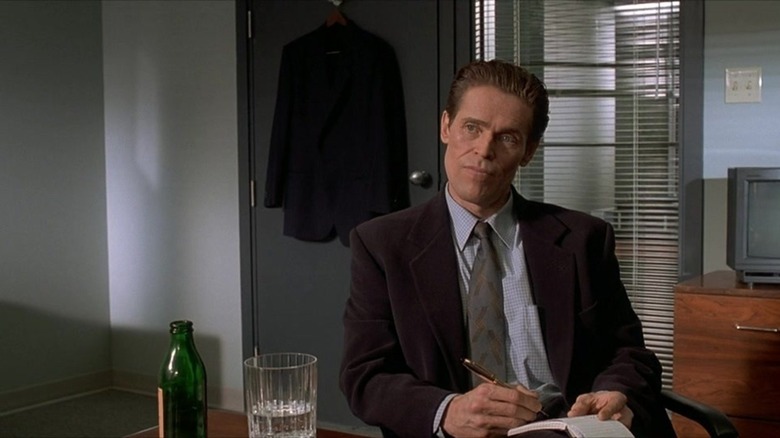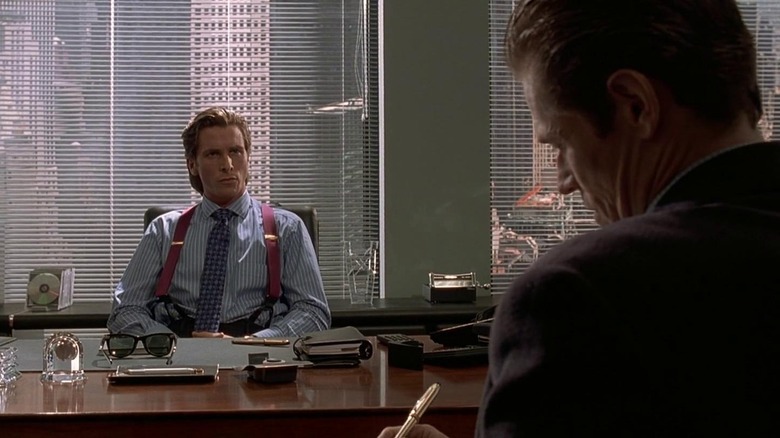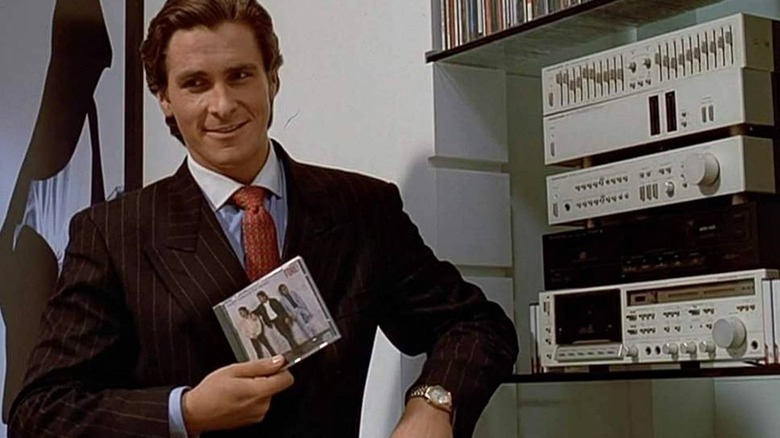Why Mary Harron Added Willem Dafoe's Detective To American Psycho's Story
Mary Harron's 2000 film "American Psycho," based on the book by Bret Easton Ellis, is a twofold satire. On one level, both Harron and Ellis sought to deconstruct and dismantle the vapid, well-moneyed, utterly amoral world of empty-hearted, wealth-obsessed 1980s yuppie Reaganauts. And on the next, Harron added a sizable takedown of maledom's pitiful macho bluster to the text. Harron and her co-screenwriter Guinevere Turner can be credited for turning Patrick Bateman (Christian Bale) from a scary, powerful black hole into a man pathetically unable to escape the dumb superficiality that goes hand-in-glove with toxic heteronormative masculinity. It should certainly be noted that both Ellis and Turner are queer authors.
"American Psycho" might be one of the most notable films about 1980s American culture ever made. For anyone who wants to get into the mindset of any tacky, aging yuppies who have held positions of power, "American Psycho" will be something of an eye-opener.
Briefly, "American Psycho" is about a bitter yuppie who is obsessed with success and the aesthetic trappings therein; the right skin, the right clothes, the right hair, the correct business cards. The fact that he is a serial killer seems overlooked by those around him, as the yuppie business systems seem designed to foster amoral, killer behavior, and allow for the exploitation of women. Patrick abuses and kills those around him according to his whims, and the world seems determined to let him get away with it.
"American Psycho" was not a runaway success — it only earned $4 million in its opening weekend — but has since grown into a cult classic, making the rounds on the midnight movie circuit, and becoming the subject of many essays and retrospectives over the years.
Donald Kimball
In one such retrospective, published in Little White Lies in April of 2020, Harron said that she saw Patrick Bateman as "sort of a buffoon." She also explained her approach to the character of Donald Kimball (Willem Dafoe), a private investigator on Bateman's tail.
Much of "American Psycho" clearly takes place in Patrick Bateman's head. Everything feels wild, a little too unhinged. In his own mind, he is peerless and strong, eager to kill off the people that annoy him or say the wrong thing at the wrong time. This is never clearer than in a climactic sequence wherein an ATM, seemingly supernaturally, asks Patrick directly to "feed me a kitten." Worry not, dear readers, the kitten escapes unscathed. Even the people in Patrick's orbit seem to be part of him, and many of his peers are equally vapid and horrible, even if they aren't also serial killers.
The one rock of reality in Harron's film is Kimball. His scenes are relatively staid and sedate. He is clearly suspicious of Bateman, but his investigative approach is to be warm and personable, qualities that few possess in the world of "American Psycho." Kimball feels like a rich-minded character out of a Dickens novel, who enters the fray carrying a whole world with him. A daytime world, in Harron's words. She said:
"I wanted to go from a scene of social satire — Bateman and his fiancé at lunch, where it's funny — to something extremely horrifically violent and there's no preparation for it. [...] I wanted to capture that sense of lurching back and forth between these daytime and nighttime worlds."
It's hip to be square
A 2021 article in Far Out Magazine revealed the unusual approach that Harron took with Willem Dafoe in Kimball's scenes, intended to keep audiences off-balance. Kimball and Patrick have three interviews together, and Harron shot each one three times. In the first take, Dafoe was directed to be assured, confident in his knowledge that Patrick was the killer. In the second take, Dafoe was asked to be merely suspicious of Bateman. And in the third take, Dafoe was to play it as completely oblivious.
Upon editing, Harron mixed and matched the three takes so that Dafoe appeared to be oblivious in one moment and assured in the next. That not only kept audiences off balance, but served as an excellent foil for Patrick's own paranoia. One might see the Kimball scenes, for all their calm and gravity, as a further extension of Bateman's mind, as if he's reading far too much into Kimball's mannerisms and body language.
In the Little White Lies interview, Harron talked about how that view was compounded by her view of Bateman as a true monster, as someone who didn't fit in with humanity. She said:
"It's more like a monster movie; you have someone who is almost a deformed human being, who doesn't have normal instincts and is filled with terror and rage. How do they operate in the world? It was almost like someone from another planet trying to fit in on Earth. We talked about it from that point of view."
Always remember: yuppies are from another planet.


